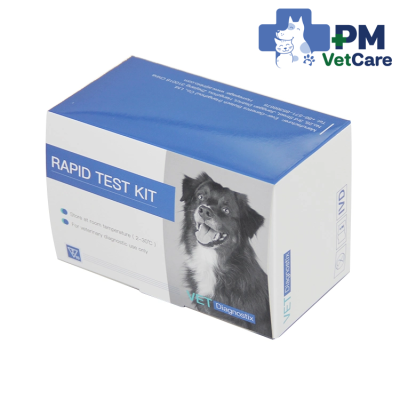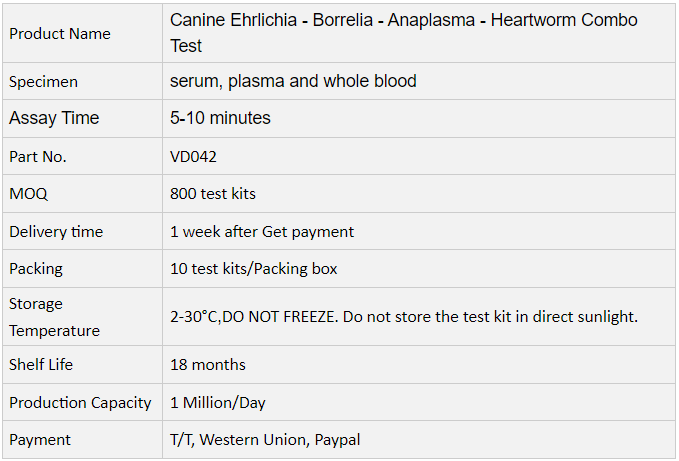

Ehrlichia-Borrelia-Anaplasma-Heartworm Combo Test
Short Introduction
The Canivet Tick-4 Combo Test is a lateral flow immunochromatographic assay for the qualitative detection of Ehrlichia canis antibodies (EHR), Borrelia burgdorferi antibodies (LYM) and Anaplasma spp (ANA) antibodies and Heartworm (CHW) antigens in dog's serum, plasma and whole blood
specimen.


Principle
The Canivet Tick-4 Combo Test based on sandwich lateral flow immunochromatographic assay. The test card has a testing window for the observation of assay running and result reading. The testing window has an invisible T (test) zone and a C (control) zone before running the assay. When the treated sample was applied into each sample hole on the device, the liquid will laterally flow through the surface of the test strip and react with the pre-coated Ehrlichia, Borrelia, Anaplasma recombinant antigens and heartworm antibodies respectively. If there are Ehrlichia, Borrelia,
Anaplasma antibodies and Heartworm antigens in the specimen, a visible T line will appear. The C line should always appear after a sample is applied, which indicates a valid result. By this means, the device can accurately indicate the presence of Ehrlichia, Borrelia, Anaplasma antibodies and Heartworm antigens in the specimen.

What are the Hazards of ticks?
1. Direct Hazard
Damage to the skin: When ticks live on the surface of animals, they will first directly damage the skin, causing the host skin to produce edema, bleeding, acute inflammation and other reactions. The sick animals often show itching, irritability, and frequent friction, scratching or gnawing. Bite the skin, which in turn leads to local bleeding, edema, inflammation, hyperkeratosis, or secondary wound maggots at the parasitic site.
Malnutrition: Ticks are blood-sucking animals, and a large number of parasites can cause animal anemia, weight loss, stunting and other symptoms.
Neurotoxin: Some ticks can secrete nerve-paralyzing toxins during the blood-sucking process, thereby causing paralysis of the host.
The salivary glands of ticks secrete toxins, which can cause anorexia, weight loss, and metabolic disorders in animals; in severe cases, they can inhibit the release of acetylcholine in the muscle nerves, causing motor nerve conduction disorders, causing acute ascending amyotrophic paralysis, leading to "tick paralysis".

Under normal circumstances, the symptoms of discomfort will increase rapidly, and the range of paralysis gradually expands and develops upward. The diseased animal cannot move or stand on its forelimbs or hind limbs, but the paralyzed part still responds to stimulation. This kind of paralysis is different from the paralysis caused by calcium deficiency. , There is no therapeutic effect after calcium supplementation, and only after the removal of ticks can it slowly recover.
Restlessness, mild tremor, unsteady gait, weakness, and lameness usually begin 5 to 7 days after the tick bites the animal.
2. Spread the disease
Ticks are blood-sucking animals. Once it bites the host animal that carries the pathogen, and then transfers the host to bite people, the pathogen is likely to enter the human body and cause disease.
The currently known diseases that may be transmitted by ticks include: forest encephalitis, Xinjiang hemorrhagic fever, tick-borne relapsing fever, Lyme disease, North Asian tick-borne rickettsial disease, bacterial diseases, anaplasmosis and other acute infectious diseases .
TEST PROCEDURE
- Allow all materials, including specimen and test device, recover to 15-25ºC before running the assay.
- Take out the test card from the foil pouch and place it horizontally.
- Place 10 μL of the prepared specimen into the sample hole, matching the window CHW. Then drop 3 drops (approx. 100 μ L) of assay buffer CHW into the sample hole. Start the timer.

-Collect 20 μ L of the prepared specimen into a vial of EHR-ANA-BAB assay buffer and mix well. Then drop 3 drops (approx. 120μL) of the diluted sample into the sample hole "S" of the test card, respectfully matching the windows EHR, ANA, BAB. Start the timer.
- Interpret the result in 5-10 minutes. Result after 10 minutes is considered as invalid.

INTERPRETATION OF RESULTS- Positive ():" C" line and "T" line exist simultaneously, whether the line is clear or blurred.
- negative(-): show clear C line. Only no T line.
- Invalid: No color line in C area. regardless of whether the T line appears or not.
